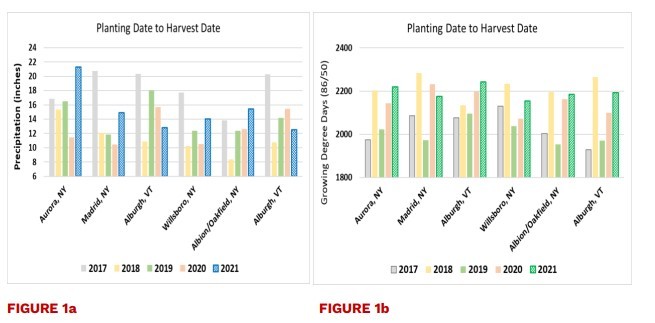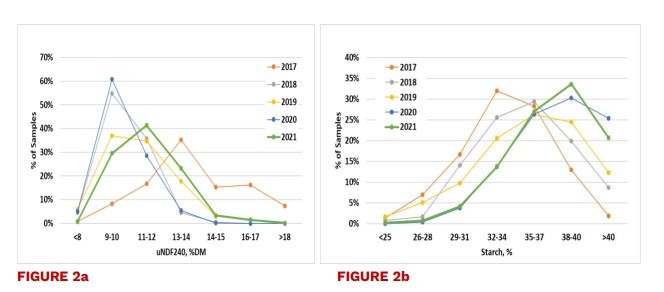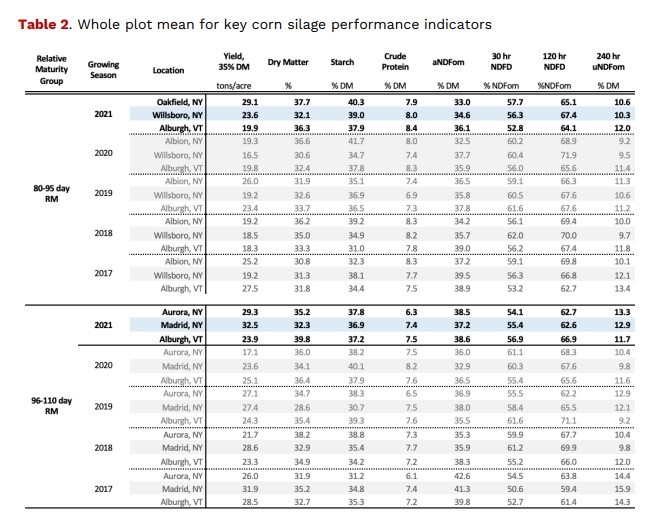2021 Corn silage overview by Joe Lawrence and Allison Kerwin
2021 Corn silage overview
by Joe Lawrence and Allison Kerwin
The growing season across much of the Northeast started with average to slightly above average heat unit accumulation and below average precipitation. This provided relatively good conditions for corn planting, with trial locations planted between May 7 and May 19 (Table 1). Conditions remained dry, with most locations receiving designations of abnormally dry or moderate drought from the U.S. drought monitor in May and June. The exception was Aurora, which received more timely rainfall throughout May and June.
At NY locations, this changed in July with rainfall well above average through July and August; however, the Alburgh, VT location remained in Moderate Drought (U.S. Drought Monitor) through harvest. This season provided another example of how seasonal rainfall totals can be misleading in a year such as this but the timing and amount of rainfall at certain stages of plant development can be very impactful. Furthermore, certain areas within the region experienced rainfall extremes far exceeding what is represented in these trials. In these areas, greater shifts in management strategies may be needed to make adjustments in feeding programs.

As 2021 corn silage sits in storage, hopefully fermenting for the next few months before being fed out, it is helpful to understand how this crop might feed compared to previous years. Using the trial results as an indicator of corn silage performance gives us an idea of average performance.
Keep in mind this is an average of certain locations and your conditions may vary. On your own farm, it is helpful to take samples of your forage at harvest and again prior to feed out to understand the opportunities and challenges as you begin to feed this year's crop. We also need to remember that while fresh samples are a very helpful indicator, some characteristics of the forage will change during fermentation, particularly starch digestibility. For the NY locations, the season ended with rainfall amounts greater than 2020 (Figure 1a); however, as noted, the season was defined by two extremes with dry conditions to start the season and excess rainfall in the latter half. Growing Degree Day (GDD) accumulation was generally higher than recent years (Figure 1b).

With these observations in weather patterns, it can be useful to look at key forage quality parameters and how the season impacted their relative values compared to previous years. Figures 2a and 2b show the differences in undigested neutral detergent fiber after 240 hours of digestion (uNDF240) and starch content, respectively. The data in Figure 2 and Table 2 represents the last five growing seasons (2017 - 2021) with results combined from all locations by year. The relatively high accumulation of GDD's with rainfall throughout the ear development stage resulted in a distribution of starch content very similar to 2020 (Figure 2b). However, in contrast to 2020, excessive higher overall rainfall and the timing which it occurred resulted in a higher proportion of samples with greater levels of uNDF240, or less potentially digestible fiber.

Each year brings its own challenges and opportunities. Given the variation in growing conditions across the region, it is critical to test your own forages to understand the sitespecific impacts of the growing season. It is important to evaluate this data in the context of your farm when selecting hybrids. The top performing hybrid at any one location or in any one category may not be a good fit for your feeding program. Factors that influence this vary by farm but include land base, soil resources, forage inventory, quality of available hay crops, access and cost of supplemental ingredients, and expectations of cow performance. The trial results and location averages serve as a means to calibrate hybrid performance to a particular growing season. These averages can be used in conjunction with a company's data on hybrids in their lineup, including hybrids not entered into these trials, to understand how a hybrid performed relative to what is realistic for a given growing season. For example, in Figure 2, we see that the highest percentage of samples have an uNDF240, percent DM value in the 11 to 12 percent category and over 50 percent of samples have a starch content of 38 percent or greater. This can be used to evaluate how close or far away from these values other hybrids performed in 2021. It is important to recognize the companies that make these trials possible through their entry of hybrids. The following companies participated in the 2021 trials: Brevant, Channel, Dekalb, Growmark FS, Hubner, Local Seed Company, Nutrien Ag Solutions - Dyna-Gro, Pioneer, Redtail (King's Agri-seed), Seed Consultants, Seedway, Syngenta - NK The full report for the 2021 NY VT Corn Silage Hybrid Evaluation Program can be found at: https://blogs.cornell.edu/varietytrials/corn-silage/

Upcoming Events
Crops, Cows & Critters - Southwest New York Dairy, Livestock & Field Crops Newsletter Sponsorship
December 19, 2025
Our two forms of publications feature research-based and timely information from our four specialists, listed to the right, along with local event notifications and Cornell University outreach. This information is provided to participants who range from dairy, livestock, and field crops producers to agricultural suppliers and consultants.
Weekly Email Update: Shared with 625+ households who have signed up with our program.
Monthly Paper Mailer: To reach our stakeholders and farmers who lack internet access, we send out a monthly mailer where your company's logo and contact information would be featured with a mailing list of 330+ households.
If you sponsor our weekly and monthly publications you reach approximately 955 households.
Visit our website to view our newsletters!
2025 Cornell Food Beverage & Animal Feed Manufacturer Survey
December 19, 2025
Industry and Educational Advocates for New York State's Food, Beverage, and Animal Feed Manufacturing industries:
As you know, NYS has a diverse food and beverage manufacturing industry, in both the types of industries that exist and the wide distribution of firms by scale. Many manufacturing firms have strong backward linkages to agricultural production sectors in the state that support both farm-level and downstream food industry firms and consumers. In collaboration with the New York State Department of Agriculture and Markets, a team from Cornell University's Charles H. Dyson School of Applied Economics and Management has recently rolled out the 2025 New York State Food, Beverage, and Animal Feed Manufacturer Survey. The industry will benefit from an updated assessment of the industry that informs private and public investments and opportunities to support firm growth and improved profitability.
Cornell Organic Field Crops & Dairy Conference
March 6, 2026
Waterloo, NY
Farmers, researchers, educators, and agricultural service providers from across the Northeast are invited to the 2026 Cornell Organic Field Crops & Dairy Conference, held Friday, March 6, 2026, from 8:00 a.m. to 4:30 p.m. at the Lux Hotel & Conference Center in Waterloo, N.Y.
Co-hosted by New York Soil Health and Cornell CALS, the annual conference brings together leaders in organic grain, dairy, and livestock systems to share practical tools, new research, and farmer-tested strategies to support resilient and profitable organic production.
Announcements
No announcements at this time.





